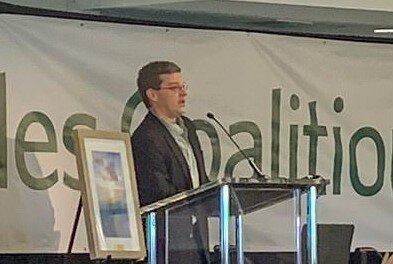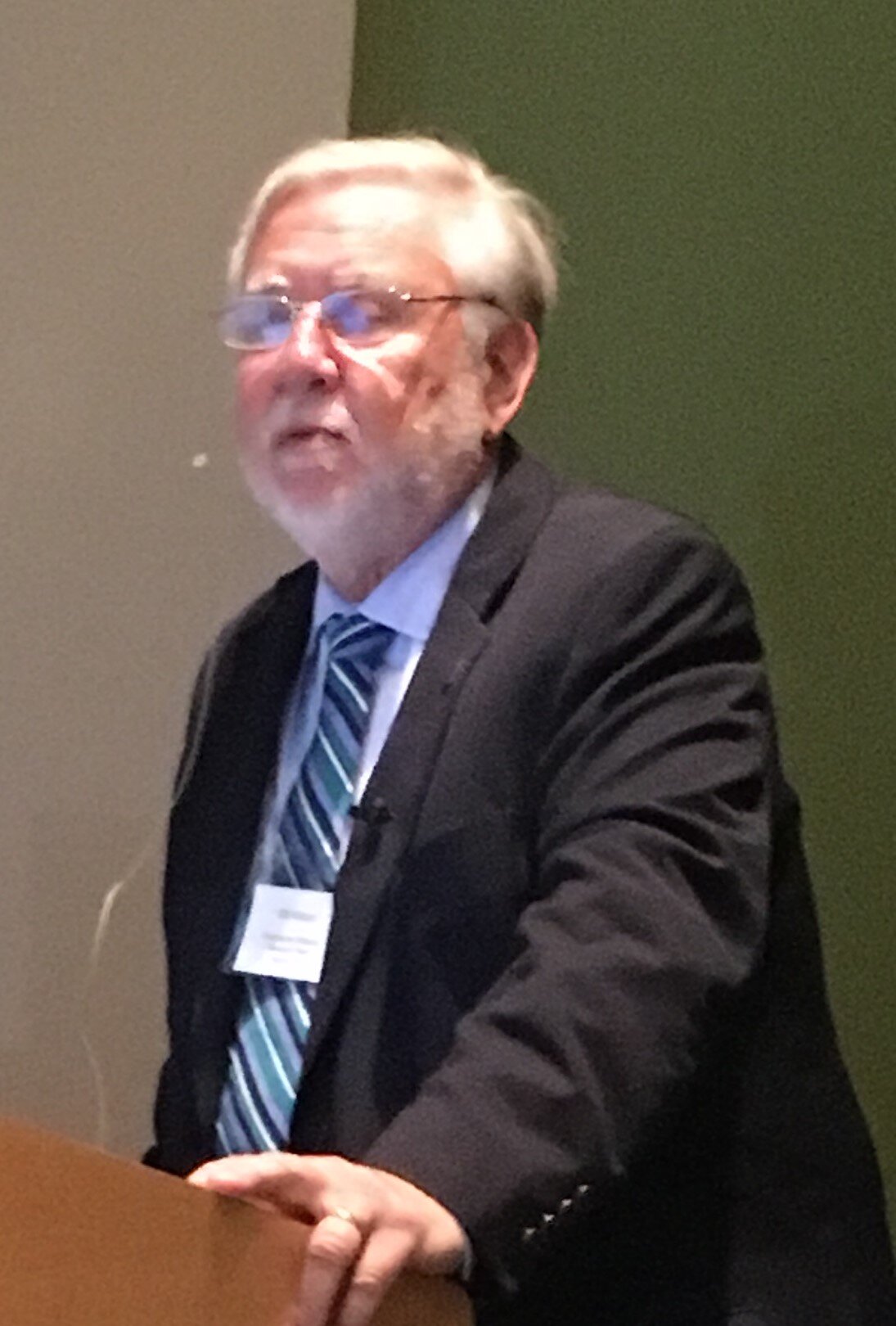Ryan Fisher, the US Army official who oversees the Corps of Engineers, speaking at the 34th Annual Everglades Coalition Conference at Hawks Cay Resort in Duck Key, Fla., on Saturday, Jan. 12. (Photo by Zack Bennet for The Daily Mail)
Today is day 27 of the Trump government shutdown
Jan. 17, 2019 by David Silverberg
Southwest Florida could be on the path to environmental renewal—but White House decisions are threatening its brightening plans and prospects.On the positive side:
Ron DeSantis (R) has clearly heard the call and responded to the area’s (and all of Florida’s) environmental needs with what are widely regarded as bold proposals that have drawn praise across the board. On Jan. 10 he issued executive orders that:
Provide $2.5 billion over the next four years for Everglades restoration and protection of water resources;
Establish a Blue-Green Algae Task Force for the next five years to examine and expedite reduction of algae blooms;
Immediately start the next phase of the Everglades Agricultural Area Storage Reservoir Project design and ensuring that the US Army Corps of Engineers approves the project according to schedule;
Create an Office of Environmental Accountability and Transparency to organize and direct environmental research and analysis and coordinate government actions;
Appoint a Chief Science Officer to coordinate and prioritize scientific data, research, monitoring and analysis.
After eight years of environmental neglect and disparagement by his predecessor, Rick Scott, these were bold proposals indeed.Dovetailing with DeSantis’ proposals, closer to home Prof. Bill Mitsch, a world-class wetlands expert at Florida Gulf Coast University, revealed both the cause of red tide and a proposed cure at a lecture he delivered on Jan. 10:
Mitsch’s research revealed that the chief culprit feeding red tide was nitrate fertilizer—after years of debate and finger-pointing, the first time the source had been so authoritatively identified;
Also contributing to red tide is nitrate-laden rainfall, much of it caused by cars using I-75. Additionally, leaking septic tanks and pollution flowing from the Mississippi River drifting across the Gulf of Mexico feed the naturally-occurring Karenia brevis organisms.
To overcome this pollution and prevent future red tides, or at least mitigate their impact, Mitsch asserted that research has shown existing or newly-created wetlands can remove much of the pollution. Mitsch calls this “wetlaculture”—deliberately cultivated wetlands. What is more, he argued that it can be done in a commercially sustainable way that benefits both farmers and the environment. Experiments to prove the concept are already under way and can be seen at a site in the northwest corner of Naples’ Freedom Park.
The site of experimental water-cleaning "mesocosms" (the tufts of grass in tubs behind the fence) in Naples' Freedom Park. (Photo by author)
Analysis
Both DeSantis’ political program and Mitsch’s scientific proposal are promising ideas that could have a major, long-term positive impact. The large-scale success of both, however, rest on a major need: funding. And when it comes to looking to the federal government for that funding, it may not be there.
While DeSantis’ pledge of $2.5 billion for Everglades restoration is commendable, he was not specific in stating where he was going to get the money. He just directed the Department of Environmental Protection, the Department of Health, Visit Florida and the Department of Economic Opportunity to “secure” it over the next four years.
There’s nothing wrong with that; such details always need to be hashed out once an idea is publicly unveiled. When he presents his first budget to the legislature we’ll see how he intends to implement it.
But it seems unlikely that the entire $2.5 billion can come from state coffers. DeSantis is no doubt counting on a portion of it to come from the federal government.
Mitsch’s idea similarly requires an initial investment. While wetlaculture holds great promise, he cautioned that it takes time.
“Wetland restoration and creation are not easy,” Mitsch warned in his lecture. “They require attention to Mother Nature (self-design) and Father Time (projects take time to reach their potential).” Indeed, under Mitsch’s proposal, restorative wetlands would take 10 years to mature before they could be “flipped” and farmed for the next five years after which they would be flipped again.
Further, the Mitsch proposal must be implemented on a massive scale. He estimates that it would take 100,000 acres of wetlaculture to ensure clean water to the Everglades—14 times more than is currently included in reservoir plans.
Mitsch admitted that creating these kinds of cleansing wetlands would take money to accomplish and while he didn’t mention figures, he also said he didn’t trust the state government to do what was necessary.
“We need the feds to keep an eye on our state government,” he said.
Indeed, such a plan, while very attractive for many reasons, would take a significant initial investment that only the federal government can provide.
Commentary
While both plans finally come to grips with south Florida’s environmental crisis they both need federal money and they’re both being proposed just at the moment when the federal government itself is in crisis (and closed, as of this writing).
What is more, President Donald Trump’s insistence on a border wall is already having an impact on Everglades restoration.
In one instance, Ryan Fisher, principal deputy assistant secretary of the Army for public works, who oversees the US Army Corps of Engineers (USACE), told Britain’s Daily Mail that if Trump were to declare a national emergency to build his border wall, it would take funds from non-essential projects like Everglades restoration. “'Look, we’re facing a national security issue. We’re waiting for more orders.” he told reporter Zak Bennet.
“I shouldn’t make any comments on the wall because I might find that I’m contradicting myself as soon as I check the news on my phone,” Fisher told the 34th Annual Everglades Coalition Conference at Hawks Cay Resort in Duck Key, Fla., on Saturday, Jan. 12. “But the president has asked us whether, if he declares the wall an emergency, we’d be ready. We assured him we’d be ready.”
At that point “We would need to decide whether other civil works projects are not essential to national defense,” Fisher said as some activists grumbled.
Emergency border wall funding would also take disaster recovery funds from Florida, Puerto Rico, Texas and California, all still recovering from local disasters.
Even DeSantis had to dissent from that scenario, his closeness to Trump notwithstanding.
“We have people counting on that [funding],” he told reporters. “If they backfill it immediately after the government opens, that’s fine but I don't want that to be where that money is not available for us.”
Conclusion
Southwest Floridians should not think that they’re unaffected by both the government shutdown and Trump’s obsessive pursuit of a border wall. These are clear examples of the local damage his behavior and erratic decisionmaking is causing.
Just days after they were proposed, Trump cast uncertainty onto environmental solutions that Southwest Florida desperately needs. It’s up to Florida’s officials and citizens to ensure that this flawed thinking doesn’t go from the conceptual stage to the point where it kills essential funding and the damage on the ground becomes real, physical and permanent.
Liberty lives in light
© 2019 by David Silverberg


